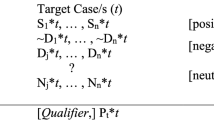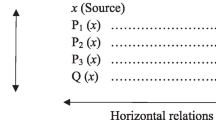Abstract
This paper proposes an account of natural analogy in scientific theorizing via Mary Hesse’s original understanding of analogical reasoning. Starting with discussing Hesse’s examples and her symbolic scheme, I argue that the traditional distinction between the type of formal analogy and the type of material analogy should be abandoned. All analogies in theorizing, that are both formal and material, contain a set of pretheoretic associations and a theoretic structure between two analogues. I thus provide a new interpretation of Hesse’s symbolic scheme to reveal the pretheoretical and the structural dimensions of analogy and further illustrate the account of natural analogy by applying it to the history of the construction of Coulomb’s law, which is traditionally seen as a typical case of formal analogy, arguing that pretheoretic associations as well as a theoretic structure play a necessary role in this case. In the final part of this paper, I argue that the account of natural analogy is preferable to Dedre Gentner’s structural mapping theory.
Similar content being viewed by others
Notes
Regarding Hesse’s account, Bartha comments: “Even though I reject Hesse's assumption about similarity and her requirement of material analogy, I think that much is right about her ‘commonsense’ theory. I have suggested replacing her causal condition with a more general requirement that the vertical relations in the source domain may be causal, logical, statistical, or other relations that reflect a ‘tendency to co-occurrence’” (Bartha 2010, p. 44). It is worth discussing Bartha’s account, but I leave it for another occasion because of the limited space.
In Chapter One of Models and Analogies in Science, Hesse simulates a dialogue between a Duhemist and a Campbellian. The Duhemist argues that two analogues in an analogy can be reduced to two instances that are deduced from a formal theory. By contrast, the Campbellian argues that analogy cannot be reduced to a deduction of instances from a formal theory. The key element is the very pretheoretic relations.
Heilbron (1979, p. 464) gives such comments on Priestley’s experiment: “it is not a demonstration, or even a proper enunciation, of the law of squares. For one, Priestley gives us no warrant for equating the ‘attraction of electricity’ with the force of a particle of electrical matter. Apart from that, he requires not Newton’s theorem—that a uniform gravitating shell exerts no force on a mass point anywhere inside it—but the converse, which he certainly could not prove. Again, a bucket is not a spherical shell. The force of gravity does not vanish within a uniform can; that of electricity does, except near the mouth, because the mobile electrical matter arranges itself on the external surface so as to nullify its action within… Finally, it appears from Priestley’s explanation of the electrification of corks grounded while hanging in the charged can that he did not fully understand his parallel. His sketchy argument did help solidify opinion, and it pointed further”.
Robison describes the instrument and the experiment in Section 85 of Volume 4 (Robison 1822, pp. 69–73). Regarding the figure of the electrometer, see Appendix, Plate I, Figures 15 and 16. Robison’s law of electricity is not yet a complete form of “Coulomb’s law,” so I won’t discuss his experiment in details in this paper.
The original: “que l’action répulsive que les deux balles électrifées de la même nature d’électricité exercent l’une sur l’autre, suit la raison inverse du carré des distances”.
The original: “que la force attractive des deux balles électrifées,……, étoit en raison inverse du carré des distances du centre de ces deux balles, même rapport déjà trouvé pour la force répulsive”.
It is noteworthy that there are many ensuing developments and applications of SMT in the journal, Cognitive Science. However, the comparison will be limited to Gentner’s (1983) paper, because it is relevant to the case discussed in this paper.
References
Bartha, P. (2010). By parallel reasoning: The construction and evaluation of analogical arguments. Oxford: Oxford University Press.
Clement, J. J. (2009). Creative model construction in scientists and students: The role of imagery, analogy, and mental simulation. New York: Springer.
Coulomb, C. A. (1785a). Premier mémoire sur l’électricité et le magnétismes. In Historie de l’Académie Royale des Sciences, Vol. LXXXV, pp. 569–577.
Coulomb, C. A. (1785b). Second mémoire sur l’électricité et le magnétismes. In Historie de l’Académie Royale des Sciences, Vol. LXXXV, pp. 578–611.
Darden, L., & Rada, R. (1988). Hypothesis formation using part-whole interrelations. In D. H. Helman (Ed.), Analogical reasoning: Perspectives of artificial intelligence, cognitive science, and philosophy (pp. 341–375). Dordrecht: Kluwer).
Davies, T. R. (1988). Determination, uniformity, and relevance: Normative criteria for generalization and reasoning by analogy. In D. H. Helman (Ed.), Analogical reasoning: Perspectives of artificial intelligence, cognitive science, and philosophy (pp. 227–250). Dordrecht: Kluwer.
Gentner, D. (1983). Structural-mapping: A theoretical framework for analogy. Cognitive Science, 7, 155–170.
Gentner, D., Holyaok, K. L., & Nokinov, B. N. (Eds.). (2001). The analogous mind. Cambridge, MA: The MIT.
Gentner, D., & Huopin, C. (1986). Systematicity and surface similarity in the development of analogy. Cognitive Science, 10, 277–300.
Gentner, D., & Kurtz, K. J. (2006). Relations, objects, and the composition of analogies. Cognitive Science, 30, 609–642.
Heilbron, J. L. (1979). Electricity in the 17th and 18th centuries. New York: Dover Press.
Helman, D. H. (Ed.). (1988). Analogical reasoning: Perspectives of artificial intelligence, cognitive science, and philosophy. Dordrecht: Kluwer Academic.
Hempel, C. G. (1965). Aspects of scientific explanation and other essays in the philosophy of science. New York: The Free Press.
Hesse, M. (1966). Models and analogies in science. Notre Dame: University of Notre Dame Press.
Holyoak, K. J., & Thagard, P. (1995). Mental leaps: Analogy in creative thought. Cambridge, MA: The MIT.
Nagel, E. (1961). The structure of science: Problem in the logic of scientific explanation. New York: Harcourt, Brace and World.
Niinilluoto, I. (1988). Analogy and similarity in scientific reasoning. In David H. Helman (Ed.), Analogical reasoning: Perspectives of artificial intelligence, cognitive science, and philosophy (pp. 271–298). Dordrecht: Kluwer.
Nyrup, R. (2019). Of water drops and atomic nuclei: Analogies and pursuit worthiness in science. British Journal for the Philosophy of Science. https://doi.org/10.1093/bjps/axy036.
Priestley, J. (1966). The history and present state of electricity, with original experiments, 3rd edn, Vol. II, London (Reprinted by Johnson Reprint Corporation, New York).
Robison, J. (1822). A system of mechanical philosophy, Vol. 4 (Ed. by John Murray. London, England. Reproduced by Cambridge University Press in 2014).
Thagard, P. (1988). Dimension of analogy. In D. H. Helman (Ed.), Analogical reasoning: Perspectives of artificial intelligence, cognitive science, and philosophy (pp. 105–124). Dordrecht: Kluwer.
Whittaker, S. E. (1989). A history of the theories of aether and electricity (New York: Dover Publications, Inc. The first edition 1951).
Wolf, A. (1999). A history of science, technology, and philosophy in the 18th century (Bristol: Thoemmes Press. The first edition 1938).
Acknowledgements
I am deeply grateful to two anonymous reviewers for their very valuable comments that substantively help improve this article. I thank Otávio Bueno, Alexandre Guay, Jonathon Hricko, Jean-Sebástien Bolduc for their very helpful comments and suggestions on the draft or on the revised version. I also thank all of the audience who attended the conferences where I presented the draft of this paper.
Author information
Authors and Affiliations
Corresponding author
Additional information
Publisher's Note
Springer Nature remains neutral with regard to jurisdictional claims in published maps and institutional affiliations.
Rights and permissions
About this article
Cite this article
Chen, RL. Natural Analogy: A Hessean Approach to Analogical Reasoning in Theorizing. Erkenn 87, 2285–2306 (2022). https://doi.org/10.1007/s10670-020-00302-8
Received:
Accepted:
Published:
Issue Date:
DOI: https://doi.org/10.1007/s10670-020-00302-8




